Duo Trusted Endpoints - Microsoft Intune Managed Endpoint Device Deployment
Last updated:
Overview
Duo's Trusted Endpoints feature secures your sensitive applications by ensuring that only known devices can access Duo protected services. When a user authenticates via the Duo Prompt, we'll check for the access device's management status. You can monitor access to your applications from trusted and untrusted devices, and optionally block access from devices not trusted by your organization.
Trusted Endpoints is part of the Duo Essentials, Duo Advantage, and Duo Premier plans.
Before enabling the Trusted Endpoints policy on your applications, you'll need to allow REST API access for Duo to your managed devices. This guide walks you through Intune configuration for Android and iOS mobile devices and Windows endpoints.
Mobile Trusted Endpoints and Verified Duo Push: Trusted endpoint verification of iOS and Android devices with Duo Mobile uses the standard Duo Push approval process and will not prompt for a Duo Push verification code, even if the effective authentication methods policy for the user and application has "Verified Duo Push" enabled.
Prerequisites
- Access to the Duo Admin Panel as an administrator with the Owner, Administrator, or Application Manager Duo administrative role.
- Access to Microsoft Entra ID as an administrator with the rights to create new app registrations.
- An Azure Subscription associated with your Microsoft Entra ID tenant.
- Intune licensing.
- If configuring for iOS devices, an Apple MDM Push Certificate that has been configured in Intune and is active.
- Deploy Duo Desktop to the Windows clients for which you want to verify management status.
Microsoft Entra ID Configuration
Perform these Azure app registration steps prior to the specific Android, iOS, or Windows configuration steps. You only need to register one Azure app for Duo to use with all three client operating systems. These instructions create a single-tenant application where the application is intended to run within only one organization.
Create Microsoft Entra ID Application
-
Log in to the Microsoft Azure Administrator console as an Azure AD administrator with the "Global Administrator" role.
-
Select the Microsoft Entra ID option from the search.
-
Navigate to Manage → App Registrations.
-
Click + New registration.
-
Enter a descriptive name for the application and select Accounts in this organizational directory only under "Supported account types".
-
Click Register. You'll be sent to the details page for the new app registration.
-
On the newly-created application's page, navigate to Manage → API Permissions and then click + Add a Permission.
-
On the "Request API Permissions" page, select Microsoft Graph from the available Microsoft APIs, and then select Application Permissions.
-
Select the following Microsoft Graph permission:
- DeviceManagementManagedDevices.Read.All
-
Click Add Permissions after selecting the Graph permission.
-
Back on the "API permissions" page you should see the list of API permissions you selected. Click the Grant admin consent for <your Azure domain name> button, and when asked if you want to grant consent for all accounts in your Azure domain, click Yes.
Create an Application Secret
-
In the Azure portal, return to Microsoft Entra ID.
-
Navigate to Manage → App Registrations and select the Duo app registration you created earlier.
-
Click Certificates and Secrets in the "Manage" section.
-
Under "Client secrets" click + New client secret. In the Description leave a comment, then under "Expires" select 730 days (24 months) (the permitted maximum). This creates a new secret, but the secret value is hidden until you save your changes. Click Add.
-
The new secret's value is shown after you save. Do not leave or close this page! You will need to copy the secret VALUE (not the "Secret ID") from this page and paste it into your Intune management integration configuration page in the Duo Admin Panel once you create the management integration in the next set of steps below for your OS platform.
This is your only chance to view the secret value! If you leave this area of the Azure portal before entering the secret Intune management integration configuration in the Duo Admin Panel, then you can't view the same key's value again and you'll have to create a new one.
It's a good idea to save this Azure secret in a secure password manager in case you need it again after you finish setting up your Intune management integration, like if you want to add support for other OS platforms in the future.
Android Configuration
Duo determines trusted device status on Android devices by leveraging the installed and activated managed Duo Mobile application on a given device to verify device information.
Use the following instructions to complete setup of your Duo Intune management integration for Android devices.
Create the Intune Integration
- Log in to the Duo Admin Panel and navigate to Devices → Trusted Endpoints.
- If this is your first management integration, click the Get started button at the bottom of the Trusted Endpoints introduction page. If you're adding another management integration, click the Add Integration button you see at the top of the page instead.
- On the "Add Trusted Endpoint Integrations" page, locate Intune in the list of integrations.
- Choose Android from the "Select operating system" drop-down, and then click the Add button.
The new Intune integration is created in the "Disabled" state. You'll turn it on when you're ready to apply your Duo trusted endpoints policy.
Please note that this integration takes advantage of managed app configuration and therefore Duo Mobile must be installed by your MDM for the device to be considered trusted.
Keep the Duo Admin Panel open in your browser while you access the Azure portal in a new window or tab. You'll need to return to the Intune management integration page to complete the Android configuration steps.
Register Azure Application for Android in Duo
-
In the Azure portal, navigate to Microsoft Entra ID → Manage → App Registrations, and then select the Duo app registration you created earlier.
-
In the Duo Admin Panel, scroll down to the "Register Azure Application with Duo" section.
-
Copy the Azure application client secret value that you created during the Azure configuration steps, and paste the copied secret into the Azure Secret Value field in the Duo Admin Panel.
-
Click Overview on the Duo Azure app registration's page. You'll see the Application (client) ID and Directory (tenant) ID listed at the top of the page.
-
Copy the Application (client) ID value from Azure and paste it into the Azure Application ID field in the Duo Admin Panel.
-
Copy the Directory (tenant) ID value from Azure and paste it into the Azure Directory ID field in the Duo Admin Panel.
-
Click Test Configuration to verify Azure API access. You'll receive a "Configuration Successful!" message if everything's correct. If the test fails, verify that you entered the right information in the Duo Admin Panel.
-
After you successfully test your configuration, click the Save & Configure button.
Setup Managed Google Play
-
In the Azure Portal, select Intune from the search. This will open the "Microsoft Intune admin center".
-
Navigate to Devices → Enrollment and then select the Android tab.
-
Select Manage Google Play in the "Prerequisites" section to connect to your organization's Google Play account.
-
Grant Microsoft permission to send user/device information to Google, and click the Launch Google to connect now button to access Google.
-
Sign in to Google using the account you use to manage and publish apps in Google Play and complete linking your managed Google Play account to Intune.
Approve Duo in the Managed Google Play Store
-
In the Microsoft Intune admin center, navigate to Apps → Android.
-
Click the +Add button and select Managed Google Play in the "App Type" drop-down. The managed Google Play Store opens.
-
Search the Google Play Store for Duo Mobile and click the Duo Mobile app icon to select it from the search results.
-
Click the Select button on the Duo Mobile app page, and click Approve again after reviewing the requested app permissions.
-
When asked "how to handle new app permission requests", select Keep approved when app requests new permissions and then click Done.
-
After you've approved the Duo Mobile app in the Play store, return the Intune Managed Google Play page and click the Sync button.
Configure Managed Duo Mobile
-
In the Microsoft Intune admin center, navigate to Apps → App configuration policies.
-
Click the Add button and select Managed devices.
-
Enter the following information on the "Create app configuration policy" page's "Basics" tab:
Name Enter a descriptive name. Description Enter additional information about this new policy, if desired. Device Enrollment Type Select Managed Devices. Platform Select Android Enterprise. Profile Select Personally/Corporate-Owned Work Profile only. -
Click the Select app link next to "Targeted app".
-
In the "Associated App" search find and and choose Duo Mobile. Click OK to return to the "Basics" tab, and then click Next.
-
On the "Settings" tab, under "Configuration settings format", choose Use configuration designer.
-
Click Add+ and select Trusted Endpoint Identifier and Trusted Endpoints Configuration Key. The Trusted Endpoint Identifier should have value type "Variable" and Trusted Endpoints Configuration Key should have value type "String".
-
Return to the Duo Admin Panel. Copy the information for these fields from Duo and paste into the corresponding configuration value fields in the Azure configuration designer:
- Trusted Endpoints Identifier
- Trusted Endpoints Configuration Key
-
Click Next after entering the information for those two configuration settings.
-
On the "Assignment" tab, choose the Azure group to which you would like to push Duo Mobile. We recommend starting with a test group. Click Next after selecting your target groups.
-
Verify the information on the "Review + Create" tab, and click Create.
Assign Duo Mobile to Android Phones
-
In the Microsoft Intune admin center, navigate to Apps → All Apps.
-
Select the Duo Mobile app with type "Managed Google Play store app".
-
Select Assignments and then click Add Group.
-
Make the following selections:
- Assignment Type: choose Required.
- Group: choose the Azure group to which you would like to push Duo Mobile. We recommend starting with a test group.
-
Click OK and then click Save.
Duo Mobile should now be available to download from the Intune Work Profile App Store on Android devices.
At this point the configured integration is disabled and applies to no users until you finish your deployment.
Verify Android Device Information with Search
After you configure the connection between Intune and Duo you can verify that a given device's information is being pulled into Duo by searching for the device identifier from the Duo Admin Panel. See Search for Device Identifiers to learn how.
iOS Configuration
Duo determines trusted device status on iOS devices by leveraging the installed and activated managed Duo Mobile application on a given device to verify device information.
Use the following instructions to complete setup of your Duo Intune management integration for iOS devices.
Create the Intune with App Config Integration
- Log in to the Duo Admin Panel and navigate to Devices → Trusted Endpoints.
- If this is your first management integration, click the Get started button at the bottom of the Trusted Endpoints introduction page. If you're adding another management integration, click the Add Integration button you see at the top of the page instead.
- On the "Add Trusted Endpoint Integrations" page, locate Intune in the list of integrations.
- Choose iOS from the "Select operating system" drop-down, and then click the Add button.
The new Intune with App Config integration is created in the "Disabled" state. You'll turn it on when you're ready to apply your Duo trusted endpoints policy.
Please note that this integration takes advantage of managed app configuration and therefore Duo Mobile must be installed by your MDM for the device to be considered trusted.
Keep the Duo Admin Panel open in your browser. You'll need to refer back to the Intune with App Config management integration page to complete the configuration steps.
Register Azure Application for iOS in Duo
-
In the Azure portal, navigate to Microsoft Entra ID → Manage → App Registrations, and then select the Duo app registration you created earlier.
-
In the Duo Admin Panel, scroll down to the "Register Azure Application with Duo" section.
-
Copy the Azure application client secret value that you created during the Azure configuration steps, and paste the copied secret into the Azure Secret Value field in the Duo Admin Panel.
-
Click Overview on the Duo Azure app registration's page. You'll see the Application (client) ID and Directory (tenant) ID listed at the top of the page.
-
Copy the Application (client) ID value from Azure and paste it into the Azure Application ID field in the Duo Admin Panel.
-
Copy the Directory (tenant) ID value from Azure and paste it into the Azure Directory ID field in the Duo Admin Panel.
-
Click Test Configuration to verify Azure API access. You'll receive a "Configuration Successful!" message if everything's correct. If the test fails, verify that you entered the right information in the Duo Admin Panel.
-
After you successfully test your configuration, click the Save & Configure button.
Approve Duo in the App Store
-
In the Azure Portal, select Intune from the search. This will open the "Microsoft Intune admin center".
-
Navigate to Apps → iOS.
-
Click the +Add button and select iOS store app in the "App Type" drop-down.
-
Click on Search the App Store, and type Duo Mobile in the app search bar.
-
Click on Duo Mobile in the search results and then click Select.
-
On the "App information" page, complete any other sections as needed and then click Next.
-
On the "Assignments" page, assign the Duo Mobile app as needed and then click Next.
-
Review the settings for Duo Mobile and then click Create.
Configure Managed Duo Mobile
-
In the Microsoft Intune admin center, navigate to Apps → App configuration policies.
-
Click the Add button and select Managed devices.
-
Enter the following information on the "Basics" tab of the "Create app configuration policy" page:
Name Enter a descriptive name for the app configuration policy. Description Enter additional information about this new policy, if desired. Device Enrollment Type Select Managed Devices. Platform Select iOS/iPadOS. -
Click the Select app link next to "Targeted app".
-
In the "Associated App" search, find and choose Duo Mobile. Click OK to return to the "Basics" tab, and then click Next.
-
On the "Settings" tab, use the "Configuration settings format" drop-down to choose Enter XML data.
-
Return to the Duo Admin Panel. Scroll down to the "Create an app configuration policy" section and copy the AppConfig XML. Paste this into the XML property list field within the Intune app configuration policy page.
-
Click Next after entering the information for the configuration settings.
-
On the "Assignment" tab, choose the Azure group or groups to which you would like to push Duo Mobile. We recommend starting with a test group. Click Next after selecting your target groups.
-
Verify the information on the "Review + Create" tab, and if correct then click Create.
At this point the configured integration is disabled and applies to no users until you finish your deployment.
Verify iOS Device Information with Search
After you configure the connection between Intune and Duo you can verify that a given device's information is being pulled into Duo by searching for the device identifier from the Duo Admin Panel. See Search for Device Identifiers to learn how.
Windows Configuration
This integration relies on having Duo Desktop present on your Intune-managed Windows endpoints. When users authenticate to applications protected with Duo's browser-based prompt, Duo matches the device information reported by Duo Desktop with managed device information obtained from Intune via API.
Use the following instructions to complete setup of your Intune with Duo Desktop management integration for Windows devices.
Create the Intune with Duo Desktop Integration
- Log in to the Duo Admin Panel and navigate to Devices → Trusted Endpoints.
- If this is your first management integration, click the Get started button at the bottom of the Trusted Endpoints introduction page. If you're adding another management integration, click the Add Integration button you see at the top of the page instead.
- On the "Add Trusted Endpoint Integrations" page, locate Intune in the list of integrations.
- Choose Windows from the "Select operating system" drop-down, and then click the Add button.
The new Intune with Duo Desktop integration is created in the "Disabled" state. You'll turn it on when you're ready to apply your Duo trusted endpoints policy.
Please note that this integration requires Duo Desktop to be installed on the device to be considered trusted.
Keep the Duo Admin Panel open in your browser. You'll need to refer back to the Intune with Duo Desktop management integration page to complete the configuration steps.
Register Azure Application for Windows in Duo
-
In the Azure portal, navigate to Microsoft Entra ID → Manage → App Registrations, and then select the Duo app registration you created earlier.
-
In the Duo Admin Panel, scroll down to the "Register Azure Application with Duo" section.
-
Copy the Azure application client secret value that you created during the Azure configuration steps, and paste the copied secret into the Azure Secret Value field in the Duo Admin Panel.
-
Click Overview on the Duo Azure app registration's page. You'll see the Application (client) ID and Directory (tenant) ID listed at the top of the page.
-
Copy the Application (client) ID value from Azure and paste it into the Azure Application ID field in the Duo Admin Panel.
-
Copy the Directory (tenant) ID value from Azure and paste it into the Azure Directory ID field in the Duo Admin Panel.
-
Click Test Configuration to verify Azure API access. You'll receive a "Configuration Successful!" message if everything's correct. If the test fails, verify that you entered the right information in the Duo Admin Panel.
-
After you successfully test your configuration, click the Save & Configure button.
At this point the configured integration is disabled and applies to no users until you finish your deployment.
Verify Windows Device Information with Search
After you configure the connection between Intune and Duo you can verify that a given device's information is being pulled into Duo by searching for the device identifier from the Duo Admin Panel. See Search for Device Identifiers to learn how.
Finish Trusted Endpoints Deployment
After creating the Duo Mobile management integration, set the Trusted Endpoints policy to start checking for managed device status as users authenticate to Duo-protected services and applications.
When your trusted endpoints policy is applied to your Duo applications, return to the Intune, Intune with App Config, or Intune with Duo Desktop trusted endpoint management integration in the Admin Panel. The "Change Integration Status" section of the page shows the current integration status (disabled by default after creation). You can choose to either activate this management integration only for members of a specified test group, or activate for all users. If you created more than one Intune management integration, you must activate each one individually.
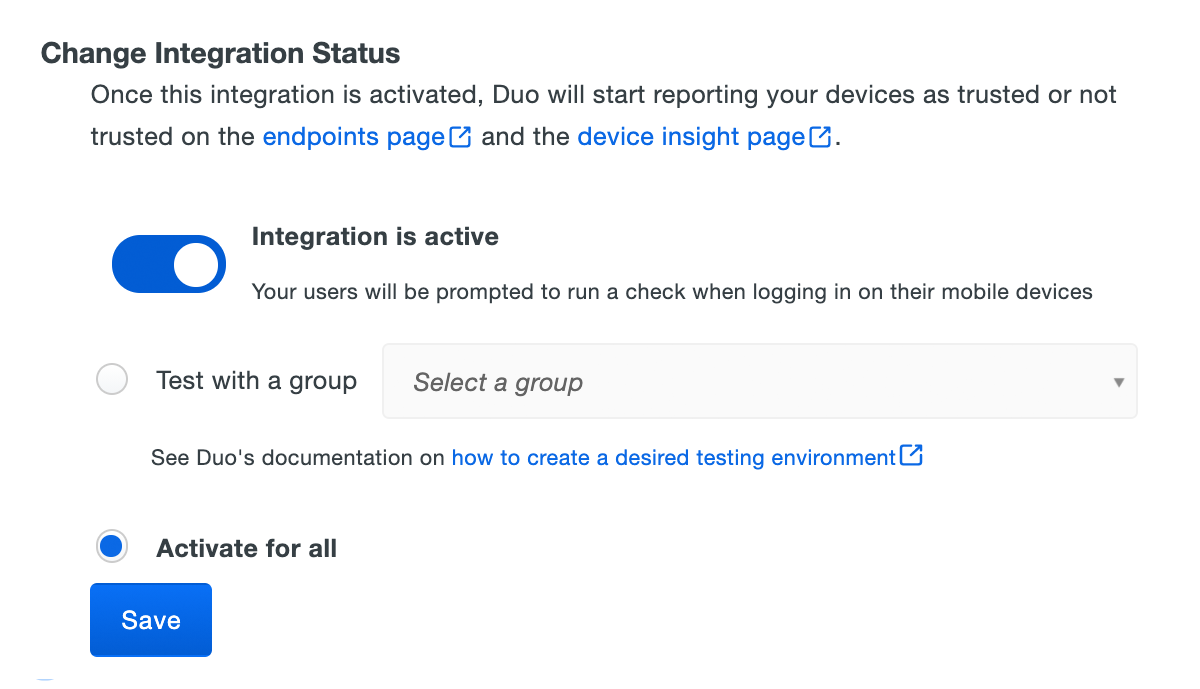
The Device Insight and Endpoints pages in the Duo Admin Panel show which access devices are trusted/managed and enrolled in Duo Mobile.
Verify Your Setup
iOS App Config and Android
Users with Duo Mobile installed and activated for Duo Push on Android and iOS devices see a device trust dialog when authenticating to a protected resource via the Duo Prompt.
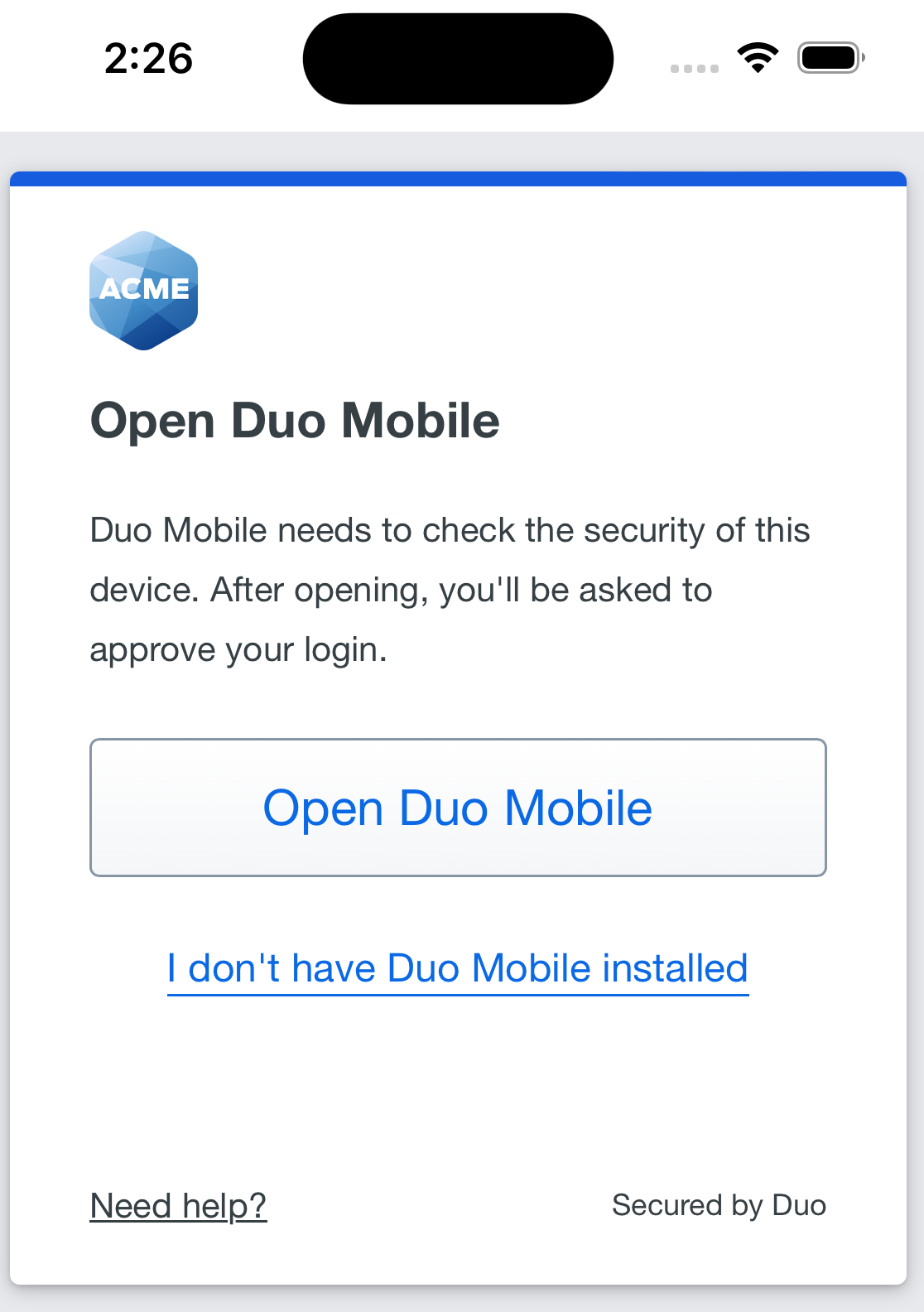
Duo uses the Azure application you created to perform a permissions check to verify device information.
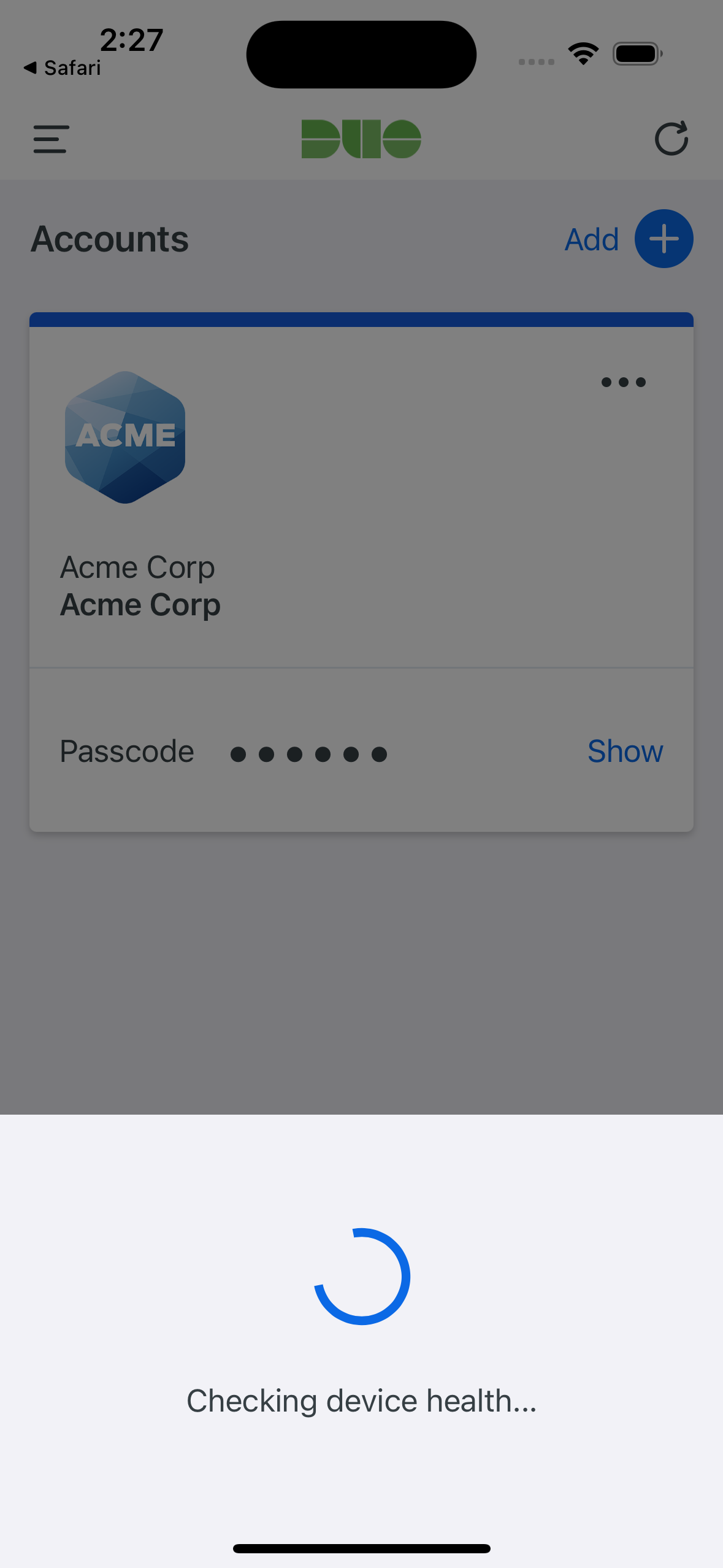
If Duo successfully verifies the Intune device information, and the user has Duo Mobile activated for Duo Push, then the user receives a login request on their phone.
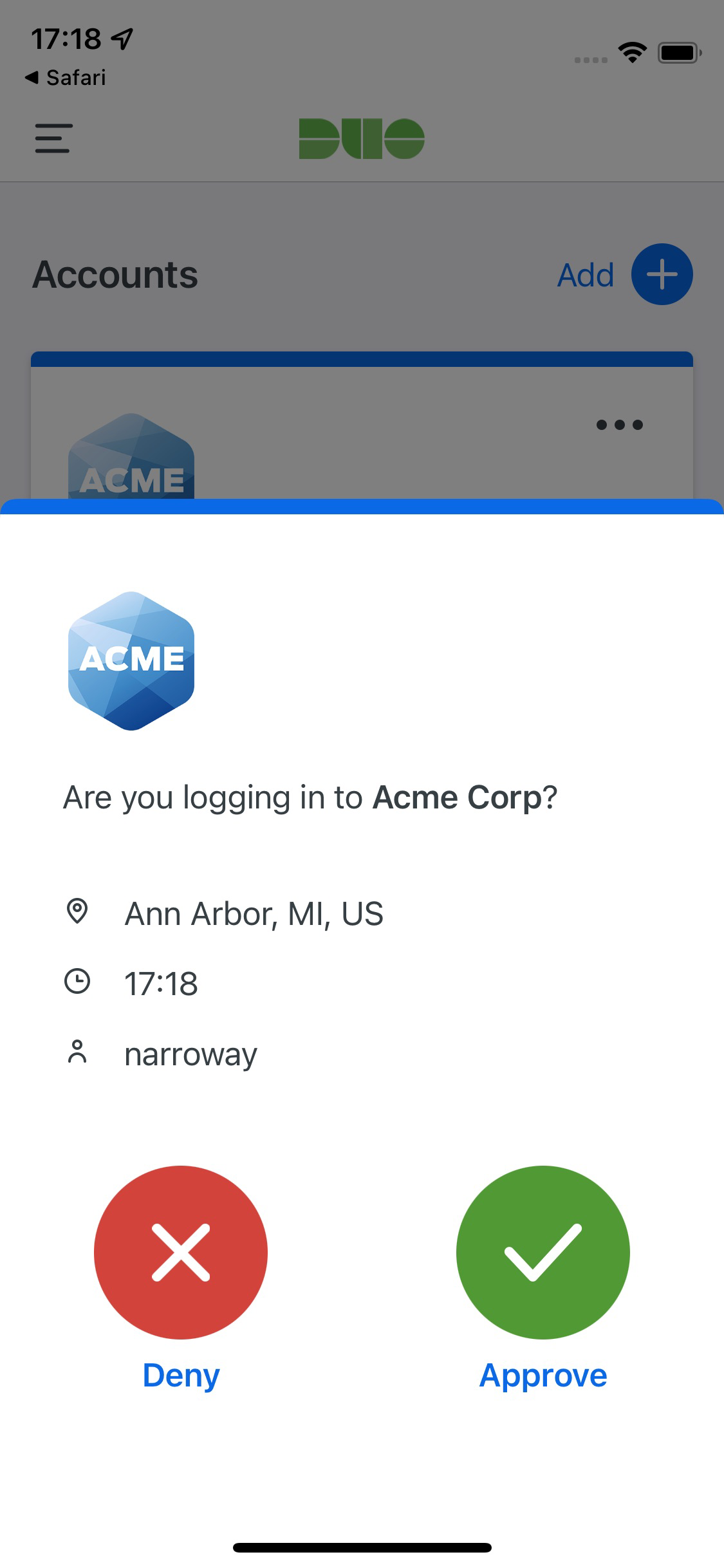
On Android devices, approving the request grants access and returns the user to the protected application. On iOS devices, after approving the Duo authentication request users tap the top-left of the Duo Mobile app to return to the application and complete login. The "Second Factor" logged for these approvals is shown as "Duo Mobile Inline Auth" in the Duo authentication log.
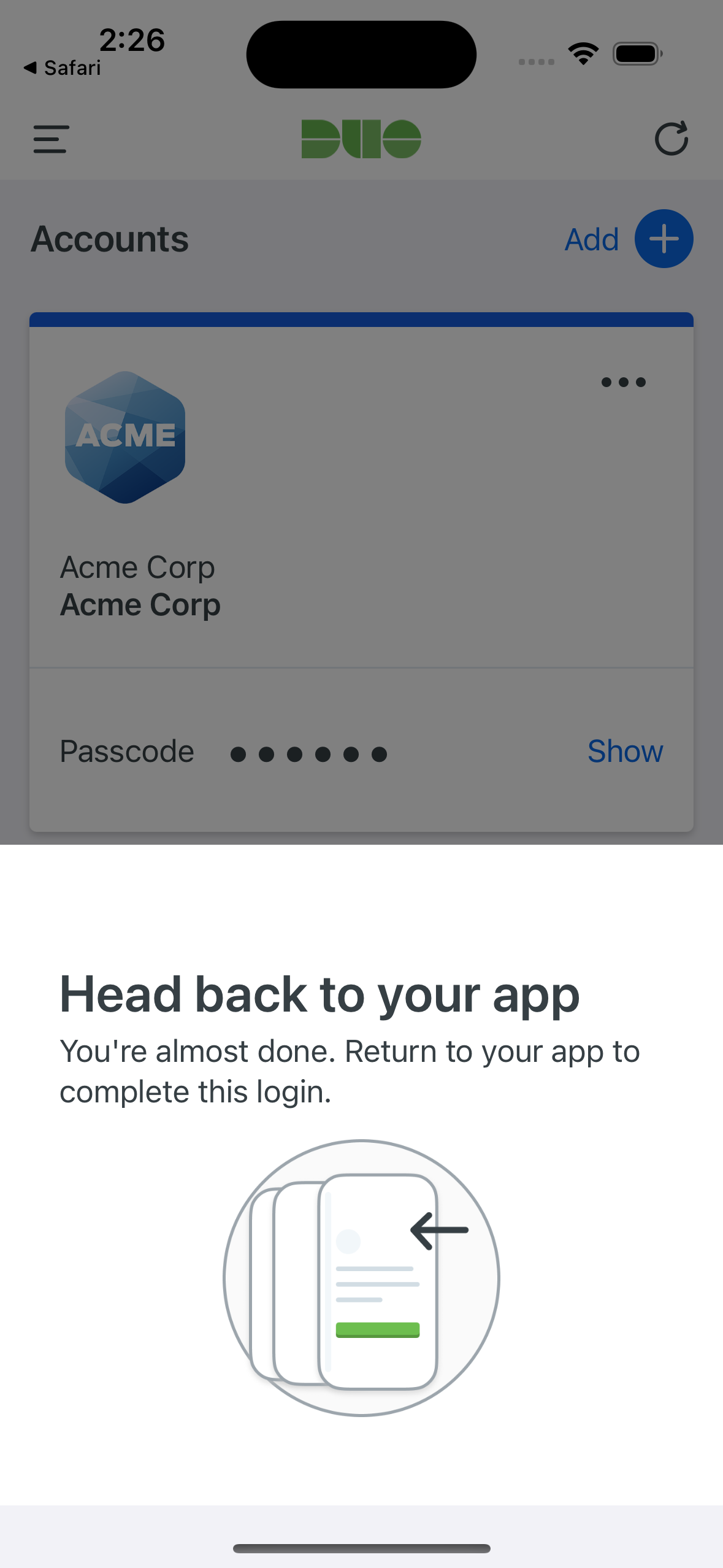
If the user does not have Duo Mobile activated for push, or does not approve the Duo request before it times out, the user returns to the Duo Prompt, where they may select from the available factors to complete 2FA.
Windows with Duo Desktop
When Windows users access Duo-protected resources, the installed Duo Desktop provides device information to Duo. If the information from the device matches the information in Azure, Duo grants access to the trusted device.
Expanding to Additional Client Platforms
You only need to perform the Azure app registration and configuration in Duo once. The same Azure app is used for Android, iOS, and Windows Intune clients. After completing the full setup for one client platform in Duo, you need only complete the OS-specific setup steps for additional client operating systems.
Saving the Azure application secret you created for future reuse in a secure password manager lets you use the same Azure AD application registered while setting up your first Intune trusted endpoints management integration for future Intune management integrations.
Removing Devices from Intune
If you need to remove a device from Intune so that Duo no longer recognizes it as a managed, trusted device, do not use the "Retire" action in Intune. Instead, delete the device from the Intune portal. If you "retire" the managed device in Intune instead of deleting the device, Duo continues to recognize the device as managed and permit a user to authenticate from that still trusted device. If you use the "Wipe" action that will also delete the device from Intune, and wipe the device as well.
Search for Device Identifiers
If you configured Duo Desktop for Windows or Duo Mobile for iOS with App Config or Android to determine device trust, you may want to search for specific device identifiers to verify that the identifier information for a given trusted device exists in Duo. This can be useful to verify a device you expect to be trusted was imported from Intune into Duo.
To search for a device identifier in Duo:
-
Log in to the Duo Admin Panel and navigate to Trusted Endpoints.
-
Locate the Intune, Intune with Duo Desktop, or Intune with App Config device management integration you want to search for a device identifier in the list and click on it to view its details.
-
In the Check if devices have synced section, enter the identifier for the device you want to check and click Search.
-
A message appears indicating if the device identifier was either found or not found. If the device identifier is not found, check your Intune API configuration and wait 24 hours.
Use these instructions to find the device identifier to search in Intune:
- Log in to the Microsoft Intune admin center, navigate to Devices → All Devices, and select a device to view.
- Under "Monitor", select Hardware.
- The "UUID" labeled "Intune Device ID" is the device identifier. Copy this value and use it to perform the search in Duo.
Removing the Intune Management Integration
Be sure to unassign your trusted endpoints policy from all applications or remove the "Trusted Endpoints" configuration item from your global policy before deleting an existing Intune integration from "Trusted Endpoints Configuration". You should also disable your Duo admin user in Intune.
Leaving the policy settings in place after deleting a management tools integration may inadvertently block user access to applications.
Troubleshooting
Need some help? Take a look at our Trusted Endpoints Knowledge Base articles or Community discussions. For further assistance, contact Support.
